Rail accidents: India
(→Causes) |
(→40% of rail mishaps are at level crossings) |
||
| Line 63: | Line 63: | ||
Around 18 accidents on unmanned crossing and three on manned have been reported since April 2015. | Around 18 accidents on unmanned crossing and three on manned have been reported since April 2015. | ||
| + | |||
| + | ==1961- 2019== | ||
| + | [[File: Train accidents per mn km travelled, 1961- 2019.jpg|Train accidents per mn km travelled, 1961- 2019 <br/> From: The sources of [ ''The Times of India'']|frame|500px]] | ||
| + | |||
| + | '''See graphic''': | ||
| + | |||
| + | '' Train accidents per mn km travelled, 1961- 2019 '' | ||
| + | |||
| + | [[Category:Crime|R | ||
| + | RAIL ACCIDENTS: INDIA]] | ||
| + | [[Category:Economy-Industry-Resources|R | ||
| + | RAIL ACCIDENTS: INDIA]] | ||
| + | [[Category:Government|R | ||
| + | RAIL ACCIDENTS: INDIA]] | ||
| + | [[Category:India|R | ||
| + | RAIL ACCIDENTS: INDIA]] | ||
==Ex-gratia payment for accidents not revised, 1997-2016== | ==Ex-gratia payment for accidents not revised, 1997-2016== | ||
Revision as of 18:25, 27 June 2023
This is a collection of articles archived for the excellence of their content. |
Causes
Jaywalking, encroachments, shorter route
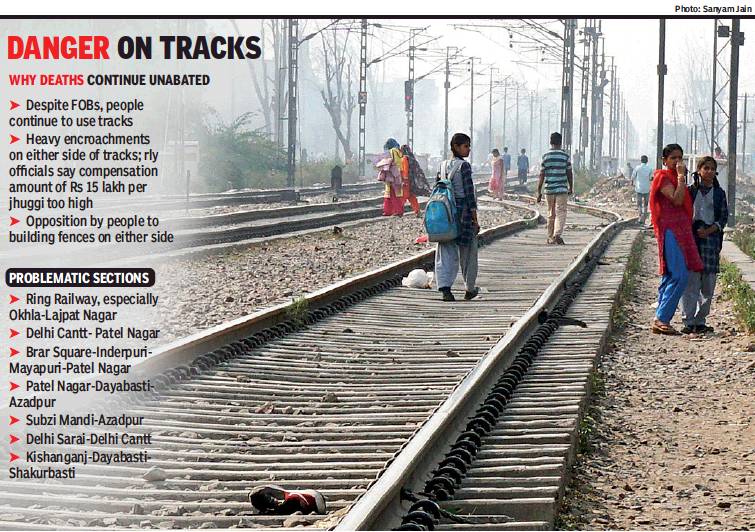
From: Jasjeev Gandhiok, Why 100 people die on rly tracks in city every year, October 30, 2018: The Times of India
JAYWALKING: Encroachments, Shorter Route To Blame
The capital hasn’t learn any lessons from the Amritsar train tragedy, it seems. Three men were crushed by a train while they were sitting on the tracks and drinking on Monday mor ning.
When TOI visited the spot just hours after the incident, people, including schoolchildren, were seen crossing the same tracks. On an average, nearly 100 people die in Delhi on railway tracks every year. Aren’t these people worried about their safety? They said they had no other option as it’s the shortest way to the other side.
On either end of the tracks are settlements, and railway officials say it becomes extremely difficult to clamp down on jaywalking on the tracks when there are encroachments.
“We identified a number of key stretches where such incidents are taking place, and while RPF personnel have been increased in some areas, people seldom listen and continue to use the tracks despite FOBs present at some locations,” said R N Singh, DRM, Delhi division.
Railway officials also say the process ofremoving jhuggis was further hampered in 2016 when the state government raised the compensation amount ofremoving a jhuggi from Rs 15,000 to Rs 15 lakh per jhuggi.
“Wherever JJ clusters have come within 15 metres of the tracks, they adversely affect track maintenance and operations. Safety also becomes a concern and we have tried making people more aware of the dangers of crossing tracks in such a manner,” said a senior railway official.
But locals complain that very little has been done to cater to their safety, with the tracks becoming gambling dens where snatchers are also on the prowl.
“People drink there at night and women can’t go near the area either. People have no option but to use the tracks to cross to the other side, as the crossing to the other colony is 2km away. People would rather risk it and use the tracks instead,” said Santosh, a 60-year-old resident of Prem Nagar, one of the colonies.
Residents of Veena Enclave at the other end of the tracks have a similar tale to tell. Kamla Devi, a housewife, said the area has seen numerous deaths in the past but RPF personnel seldom patrol the area. “No one is present to deter people from going on to the tracks and there is no security at night. People feel unsafe as a lot of crime also happens at night when those returning from work are crossing the tracks,” said Devi.
Railway officials said they are trying to secure critical points by adding fences. “People have opposed fencing as they want to continue using the tracks. But penal action and more FOBs should change things,” Singh said.
Year-wise statistics
See graphics on this page, including 'Train accidents with the highest number of casualties, 1988- Nov 2016'

ii) The highest number of casualties was in 1981;
iii) The number of people who travel by trains in India every day.
The Times of India
See graphics on this page, including 'Train accidents with the highest number of casualties,2006- Nov 2016'
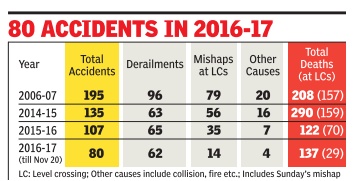
The Times of India
See graphics on this page, including ‘Rail accidents in India: 2009-March 2015’ and Train accidents with the highest number of casualties, 1995- Nov 2016

The Times of India and The Indian Express
40% of rail mishaps are at level crossings
The Times of India, Aug 25 2015
40% of rail mishaps are at level crossings
Mahendra Singh
Mishaps at level crossings are the biggest killers, accounting for 40% of train accidents and 66% of fatalities, reflecting the cashstrapped railways' failure to eliminate these crossings by building road-over bridges and road-under-bridges.
The latest data shows that there are 29,487 level crossings, of which around 10,440 are unmanned. Between 2008 and 2015, only 1,344 manned and 7,650 unmanned crossings have been eliminated. In 2015-16, railways targets to get rid of 820 unmanned and 205 manned crossings.
Around 18 accidents on unmanned crossing and three on manned have been reported since April 2015.
1961- 2019
See graphic:
Train accidents per mn km travelled, 1961- 2019
Ex-gratia payment for accidents not revised, 1997-2016
IANS, Damages for train accident victims unchanged for 19 yrs', 21 Nov 2016
Even though the cost of living and medical treatment have shot up manifold in the last two decades, the ex-gratia amount given to the kin of those killed in rail accidents has remained unchanged for the last 19 years.
The Rs 4-lakh ex-gratia was fixed way back in 1997, and it continues to be the norm even in 2016. This is in sharp contrast to the previous practice of upward revision of the amount every 10 years or so. For the first time in Independent India, Rs 10,000 ex-gratia was fixed for the families of the dead in a 1962 train disaster, which was doubled in 1963.
[Indpaedia points out that railway fares have not been revised much since 1997 either. Secondly, travel insurance is available for less than Re.1.]
2012-17: Deaths at unmanned level crossings dip 66%
`Deaths at unmanned level crossings dip by 66% in 5 yrs’, August 14, 2017: The Times of India

A parliamentary panel has found that the number of train accidents as well as casualties at unmanned level crossings has come down in the last five years.
Railways Convention Committee, in its report submitted in Parliament, noted that the number of accidents in 2012-'13 was 53, which came down to 20 in 2016-'17. The committee, headed by BJD MP Bhartruhari Mahtab, found that the number of casualties due to accidents at unmanned crossings has come down from 123 in 2012-'13 to 40 in 2016-’17.
The panel found that as many as 6,169 unmanned level crossings have been eliminated in the last five years, the highest (1,503) being in 2016-'17. “What is more encouraging is the fact that three zonal railways -Central, Eastern and West Central -have been able to completely eliminate unmanned level crossings,“ it said.
As of April 2017, there were 27,054 level crossings on the railways network: 19,504 manned and 7,550 unmanned.
The Railway Board chairman informed the committee that as of April 2017, the total number of unmanned crossings (in broad gauge) were 4,943 and it intended to remove them in three years. Railways has set the target of elimination of 1,500 unmanned crossings in 2017-'18, 1,500 in 2018-'19 and 1,943 in 2019-’20.
The committee has also suggested that the railways pay compensation to road us ers who are killed or injured at level crossings, without making them go through the judicial process. It recommended that the cause of each accident at level crossings should be investigated, preferably by an outside agency .
“...and if lapses on the part of the railways are established based on such investigations, Indian Railways should suo motu pay compensation to the road users also, instead of waiting for a decree by the MACT (Motor Accident Claims Tribunal) or any other court so as to avoid time consuming process of litigation,“ it said.
As of now, under the Railways Act, 1989, liability of the railways to provide compensation is limited to rail passengers who are victims of accidents. Road users are given compensation only if decreed by MACT or another court.
2014-17
See graphic:
Major railway accidents, 2014-17
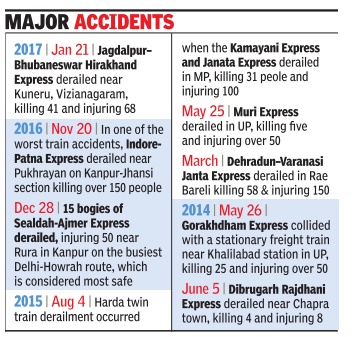
Sabotage cases, February 2017
See graphic:
Suspected cases of rail sabotage, February 2017
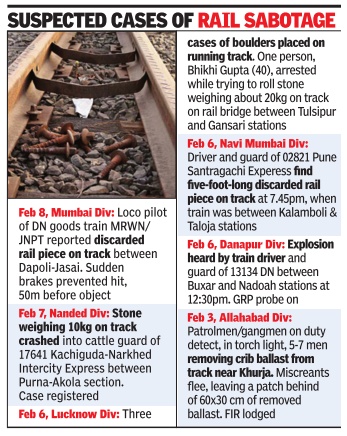
The Times of India, August 23, 2017
2007-17, number of accidents
The Times of India, Aug 23, 2017
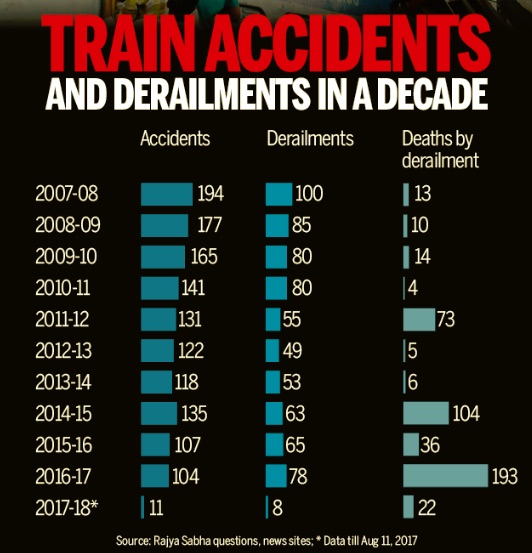
See graphic: Train accidents and derailments, 2007-2017
Fatalities from train derailments in 2016-17 were the highest in the last decade at 193. This despite a drop in train accidents in the last two years. However, the two accidents in August 2017—the derailment of the Utkal Express on August 19 and the Kaifiyat Express on August 23, have once again raised questions about the Railways commitment to passenger safety and the delayed implementation of safety norms.
2012-17: derailments and fatalities
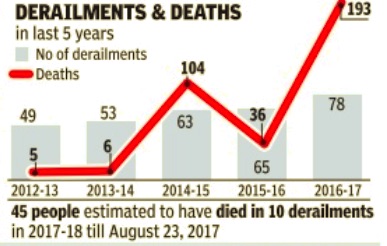
From The Times of India, August 24, 2017
See graphic, Derailments and deaths, 2012-17
2016-17: most accidents since 2011

The principal causes of railway accidents in India
From: May 24, 2018: The Times of India
See graphic:
Passengers killed in accidents, 2001-2017.
The principal causes of railway accidents in India
2017-18: Railways' best safety record in 5 years
With 40 deaths in 75 accidents between September 2017 and August 2018, the Railways has registered its best safety figures in five years for the corresponding 12-month period, a ministry official has said, quoting official data.
There were 80 train accidents and 249 fatalities between September 2016 and August 2017 -- the Indore-Patna Express derailment near Kanpur in November 2016 alone had killed over 150 passengers. In the corresponding period for 2017 and 2018, the number of deaths stood at 40, the official said.
There were two major accidents during this period -- the derailment of the Utkal Express in August 2017 which killed over 20 people, and the the death of 13 children in Uttar Pradesh on April 26 this year after a train rammed into their school van.
Similarly, between September 2013 and August 2014, the number of deaths was 275 in 139 accidents, in the corresponding period in 2014-2015, the number was 196 deaths in 108 accidents.
"Comparing the figures of the period between September 1, 2013 to August 31, 2014 to that of the number between September 1, 2017 to August 31, 2018, the fatality figures in collisions and derailments (whose causes the railways can address, according to the official) taken together have come down from 62 to 4- a 93 per cent reduction," he said.
"Whereas injury figures in collision and derailment came down from 272 to 12 (95.6 per cent reduction). The total number of collision and derailments have come down from 69 to 56 during this period," the senior official said.
The rest 36 deaths in 2017-2018 were accounted for by other factors such as mishaps at unmanned-level crossings (28 fatalities), six deaths at manned-level crossings, one in a coach fire accidents and one in "miscellaneous" accidents, according to the official data.
"Better tracks, replacement of existing coaches with LHB ones and more focus on maintenance in the last four years have resulted in fewer accidents due to technical reasons," he said.
The official further said that the vast reduction in injuries and fatalities happened primarily because of the massive renewal of tracks, regular safety reviews, better safety training of staff and close monitoring of safety performance undertaken during the period.
Another aspect which has contributed to better safety figures is removal of unmanned level-crossings — the railways plans to eliminate them completely by March 2020.
The national transporter has been aggressively removing UMLCs — 1,565 of them were eliminated in 2017-18 which resulted in fewer accidents. The target is of removing 1,600 such UMLCs in 2018-19, the official said.
The number of accidents at unmanned level crossings owing to the negligence of road vehicle users during September 2013 to August 2014 was 52, in the corresponding period in 2014-15 the number stood at 39, in 2015-2016 it was 23, in 2016-17 it was 13 and it reduced to just eight in the corresponding period of 2017-18, according to the data. Download The Times of India News App for Latest India News.
`Unofficial' track repair work
The Utkal Express mishap, which claimed 23 lives, has brought into focus smaller incidents that keep happening due to “unofficial“ maintenance of tracks where repair work is undertaken without taking permission from authorities and not following prescribed norms.
In this “short-cut“ method, officials do not put any speed restriction, such as red flag or signal warning, on the route and try to complete the maintenance work when there is no train operation.
Several officials of engineering department admitted that on many occasions they resorted to the practice of “unofficially“ doing repair works as seeking “block“ (time period) might delay some trains running on the route, which in turn gets reflected in performance report of the concerned officer and of the division and zone. “Due to heavy traffic, it is also very difficult to take blocks for maintenance. We are also under tre mendous pressure to do repair work on time,“ an official told TOI. There is a provision that in an emergency situation maintenance work can be done by putting up red flags on both the sides at 1200 metres.
As reported by TOI, the engineering department of Delhi division was doing repair work “unofficially“ at Khatauli and railways has admitted maintenance work was on without proper norms.Mohammed Jamshed, member (traffic), railway board said it was not “clear“ what kind of work was going on at the site. “We have maintenance ma nuals which lay down guidelines for work on any kind of railway infrastructure.“
As per reports, officials were aware 14-15m of track at the accident site needed urgent repairs, but they resorted to “short-cut“ since the stretch saw heavy traffic and feared causing delays would reflect poorly on records.
Another issue is recruitment of overqualified track maintenance staff. “MBAs, BE engineers are joining as trackmen who are not ready to listen to supervisor. Most are preparing for other competitive exams so try to get posted at the bungalows of senior officials,“ said a source.
With railways struggling to check increase in deaths due to 50% spike in cases of derailments of trains, Niti Aayog has found that while human failure accounted for 87% of mishaps, there has been a 60% increase in number of accidents for which engineering directorate was responsible.
Accidents due to failure of railways staff stood at 64 (2016-17) against 55 (2015-16), 60 (2014-15). Failure of staff accounted for 61.5% of the total accidents in 2016-17.
Those dying getting on, off train, must be paid by the Railways: SC/ 2018
Transporter To Compensate For Injuries Too: SC
The Supreme Court ruled that the railways would be liable to pay compensation to passengers in case of death or injury while boarding and de-boarding trains and said it cannot deny such claims citing negligence on the part of passengers.
A bench of Justices A K Goel and R F Nariman held that death or injury during boarding or de-boarding a train will be an ‘untoward incident’ entitling the victim to compensation.
As per Section 124A of the Railways Act, 1989, no compensation shall be payable by the railway administration if the passenger dies or suffers injury due to suicide or attempted suicide by him, self-inflicted injury, his own criminal act or any act committed by him in a state of intoxication or insanity.
Different high courts have given contradictory verdicts as some of them held that injury or death during boarding and deboarding because of negligence of the victim was at par with self-inflicted injury. Some HCs though applied the principles of strict liability on the railways for such incidents.
Putting an end to the controversy, the apex court ruled that the railways is liable to pay compensation to victims as compensation is payable whether or not there has been wrongful act, neglect or fault on the part of the railway administration in case of an accident or untoward incident.
The court said the concept of ‘self-inflicted injury’ would require intention to inflict such injury and negligence on the part of passenger, which is one of the grounds to decline compensation, could not be brought within its ambit.
